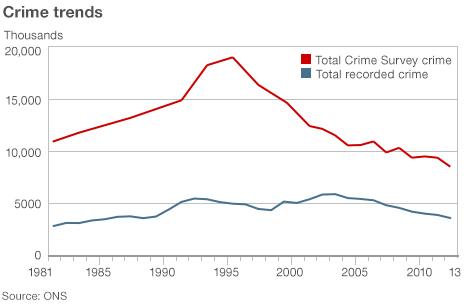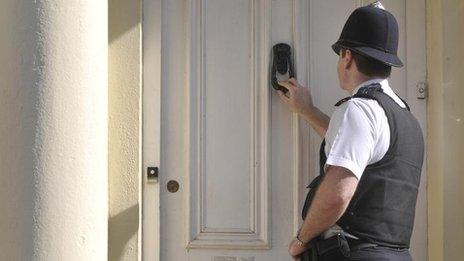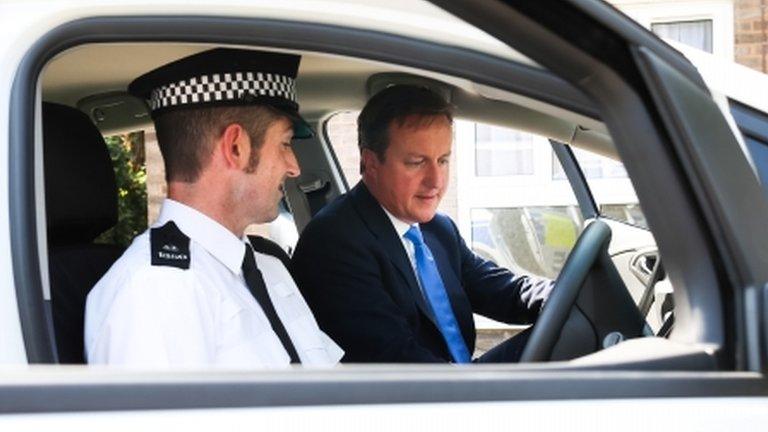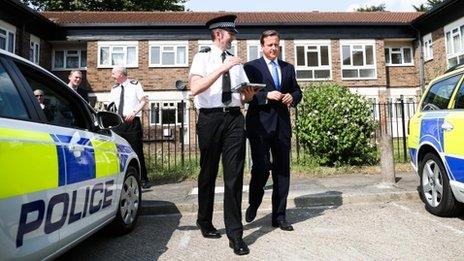Analysis: Is the thin blue line thinner?
- Published
- comments
How thin is the thin blue line? That's the question after three years of cuts to police forces in England and Wales - and the prospect of more to come.
Thursday saw the publication of three important reports on police and crime. And they point in the same direction. The evidence seems to show it is possible to cut the costs of policing while improving public confidence.
The number of crimes recorded by police in England and Wales fell by 7% in the year ending March 2013.
That fall, broadly backed up by separate figures in the government's Crime Survey for England and Wales, means a downward crime trend which dates back to the mid-1990s is continuing.

Now, this is the interesting part. The number of police officers has fallen below 130,000 for the first time since 2002. That means there are 14,000 fewer officers than the record high of 2009-10.
What's more, another official survey says victims are more satisfied than ever with police performance.
So is this proof that it doesn't matter how big your police force is, but what you do with it that counts?
Corny cliches aside, it might be - but the evidence is very, very complicated.
It's stating the obvious that putting a police officer on every street corner would clean up muggings overnight. But the world isn't like that - and the success of the coalition's crime strategy partly relies on the numbers game not being the main game.
This is where the HMIC comes in, because it is analysing the capability of the police to cope with cuts.
Its latest report is broadly good news for the polic, externale - but also makes clear that some forces are at a critical juncture between getting it right - and setting themselves up to fail.
Coping with cuts
The HMIC says most of the 43 forces have responded well to cuts because chiefs have tried to wield the axe smartly, rather than just swiftly.
But it warns that five forces could struggle with cuts after 2015.
Two of them - Bedfordshire and Lincolnshire - are small forces which appear to have few options left. In contrast, the HMIC says that the much larger West Yorkshire and South Yorkshire forces have made short-term savings rather than "transforming their efficiency" - jargon for rethinking the organisation from top to bottom.
The final force, Northamptonshire, is described as having "significant performance issues" which it will struggle to deal with while making the cuts.
Putting aside those five, what are the other forces getting right? The HMIC says it comes down to focus on the frontline, collaboration and modernisation.
Big spending years
During the big-spending Labour years, police numbers swelled. But critics say the cash wasn't used efficiently.
Official figures show that the proportion of officers on the "front line" began to decline despite police strength rising. That's because more and more of them were doing jobs in the station rather than dealing directly with crime.
That trend has now reversed and some forces are close to having nine out of 10 officers in frontline jobs - with Dorset aiming for 97% by 2015.
What that means, says the HMIC, is that forces are trying harder to protect the front line - even if they cannot preserve the numbers.
But here's the problem - what happens when the cuts become very tight indeed?
The HMIC says that neighbourhood policing teams are being eroded - the teams that know and understand their beat. These officers are doing more work in the stations or joining emergency response units which, according to Labour, are already struggling thanks to cuts.
What's more, the inspectorate says that in some areas these officers have been replaced by Police Community Support Officers who have no powers of arrest.
The inspectorate won't say this is the death knell for the "bobby on the beat" - but it could change the balance between preventing crime and reacting to it.
And this is the central point that Tom Winsor, the chief inspector of constabulary, keeps making. He says the police must spend more time focusing on would-be offenders, likely victims and potential crime hotspots because that ultimately cuts crime and saves money.
Steve White of the Police Federation: "We've got to the absolute limit"
The vice-chair of the Police Federation of England and Wales, Steve White, says he believes police forces are at the limits of what they can do with their current resources.
So how can cuts be made to work? The answer says the HMIC is technology and collaboration - but the results so far are extremely patchy.
Tom Winsor says that in these days of smartphones, too many officers are putting their own devices in station lockers and are going out carrying mobile phones which are basically useless bricks.
These same officers are wasting time going to and from the station to perform simple tasks that, as anyone with a mobile internet enabled device knows, could be done remotely and instantaneously. Too many police forces are stuck in the technological dark ages.
The bigger problem, says the HMIC, is the "missed opportunity" of collaboration. Some forces are working so closely together now that it amounts to a "merger by osmosis".
But others aren't working with their neighbours at all and are duplicating expensive jobs which they could do together or out-source.
So this appears to be the real challenge as the cuts will continue. If forces cannot rethink every single part of what they do, then they cannot ensure that they have maximised the numbers of officers who are focused on crime. And that's when the thin blue line, may become very thin indeed.
- Published16 July 2013

- Published18 July 2013

- Published18 July 2013
